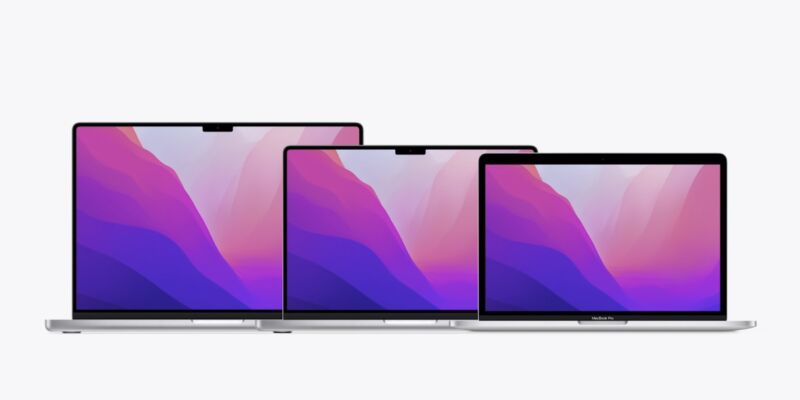
Capping a week of Apple rumors about the company's mixed-reality headset plans and its efforts to design its displays and wireless chips in-house, Bloomberg's Mark Gurman reports that Apple might reverse years of design decisions and rhetoric and add touchscreens to a future MacBook Pro refresh.
The report says Apple's hardware engineers are "actively engaged in the project" and that the company is "seriously considering" the move, but "plans could change" before the touchscreen Mac's possible launch in 2025—don't expect them to come with the M2 MacBook Pro refresh we're expecting this year.
If true, this wouldn't be the first time Apple tested Mac touchscreens internally. In fact, multiple company execs over the last decade-plus have gone on the record to say that Apple has tested touchscreen Macs—usually while explaining why they think touchscreen Macs are a bad and unworkable idea.
"We've done tons of user testing on this, and it turns out it doesn't work," said then-Apple CEO Steve Jobs in 2010, talking about why the company was focusing on its Mac touchpads instead. "Touch surfaces don't want to be vertical. It gives great demo but after a short period of time, you start to fatigue and after an extended period of time, your arm wants to fall off. It doesn’t work, it’s ergonomically terrible.”
"You can converge a toaster and a refrigerator, but those aren't going to be pleasing to the user," said current Apple CEO Tim Cook in 2012 of Microsoft's attempt to converge PCs and tablets with Windows 8 convertibles. "I think the [MacBook Air] appeals to someone who has different requirements. You wouldn't want to put these things together."
"We don't think it's the right interface, honestly," said Apple's software engineering SVP, Craig Federighi, in 2014 when the first 5K 27-inch iMac launched. "Mac is sort of a sit-down experience. Over the years, we've experimented with all the technology, but we found it just wasn't good... We're not all that interested in building one."
"If we were to do multi-touch on the screen of the notebook, that wouldn’t be enough—then the desktop wouldn’t work that way,” said Apple's Phil Schiller in a 2016 interview. "Our teams worked on that for a number of times over the years. We've absolutely come away with the belief that it isn't the right thing to do."
"We really feel that the ergonomics of using a Mac are that your hands are rested on a surface, and that lifting your arm up to poke a screen is a pretty fatiguing thing to do," said Federighi in 2018, speaking about its plans to allow easier porting of iOS apps to future versions of macOS.
“I gotta tell you when we released Big Sur, and these articles started coming out saying, ‘Oh my God, look, Apple is preparing for touch,’" said Federighi in 2020, "I was thinking like, ‘Whoa, why?’"
"We make the world's best touch computer on an iPad," said Apple hardware engineering SVP John Ternus in 2021. "It's totally optimized for that. And the Mac is totally optimized for indirect input. We haven't really felt a reason to change that."
We collect these quotes not to suggest the Bloomberg report is incorrect, but to show that Apple engineers and top brass have tested touchscreen Macs before and found them wanting, and most of the executives who have made those decisions over the years are still with the company. Bloomberg says that there is "pressure" on Apple to add touchscreens to Macs because its competitors in the PC space are doing so, but PC makers have been doing that for a decade now, so that pressure isn't new, either.
If Apple changes its long-held stance and adds touchscreens to Macs, the report says that they won't result in any kind of combined iPad and Mac operating system—iPads will continue to run iPadOS, and Macs will continue to run macOS. But the touchscreens would support multitouch gestures and would presumably be useful for people who run iOS and iPadOS apps and games on their Apple Silicon Macs.
The closest Apple has come to adding a touchscreen to Macs so far is the Touch Bar, a horizontal strip of screen that replaced the function row on some MacBook Pro keyboards in 2016. The Touch Bar could dynamically change its contents based on the app you were using, but few third-party developers effectively used the technology. Apple has steadily replaced the Touch Bar with a new row of function keys in recent refreshes, and the 13-inch MacBook Pro is the only one of Apple's current laptops to include one.
"course" - Google News
January 12, 2023 at 11:47PM
https://ift.tt/2r4QYVC
Report claims Apple could reverse course and add touchscreens to Macs - Ars Technica
"course" - Google News
https://ift.tt/32vrUwp
https://ift.tt/kx7JOVG
Bagikan Berita Ini














0 Response to "Report claims Apple could reverse course and add touchscreens to Macs - Ars Technica"
Post a Comment